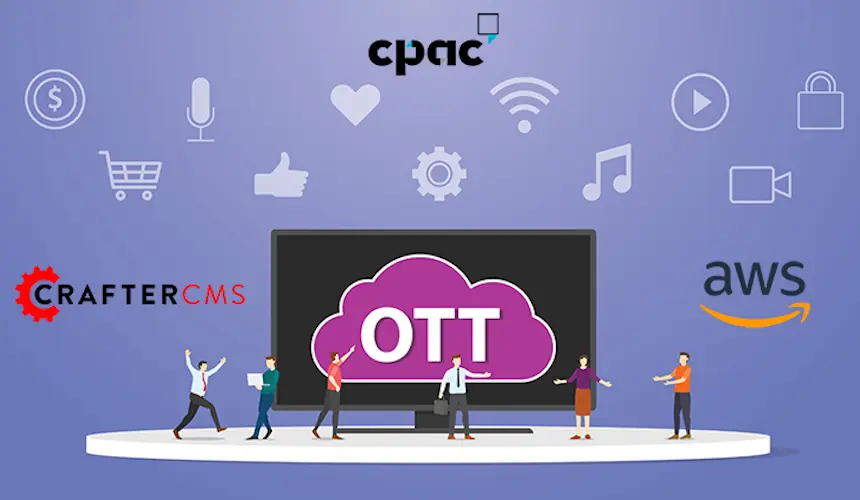What is a React CMS?

Amanda Jones

React is one of the most popular JavaScript libraries available and a choice for many web developers building content-driven applications. Ease of use, scalability, and flexibility are just a few reasons for that.
However, when paired with a headless CMS React’s benefits can be felt by marketers and content authors as well. In this blog, we’ll explore what makes a React CMS and the features enterprise developers should consider when selecting one.
What Is a React CMS?
A React CMS is a content management system built for developing content-driven React web applications. Unlike traditional CMS platforms, which often render server-side HTML, a React CMS provides a headless API-first content platform and enables developers to leverage the power and capability of React to create dynamic, fast, and interactive user experiences.
Headless architecture is typically the underlying architecture powering a React CMS. This means that developers can use a React CMS to build frontends not only with React but with any JavaScript framework.
Why React?
React, commonly referred to as React.js or ReactJS, is a widely used, free, open-source frontend JavaScript library designed to create user interfaces with reusable UI components.
Initially developed by Facebook (now Meta), it provides a foundation for developing single-page applications (SPAs), mobile apps, and server-rendered applications.
Stack Overflow’s 2023 survey ranks React as the most popular web technology used among professional developers, with 42.87% of respondents indicating they preferred building applications using the library.
In the same survey, Next.js ranked 8th among professionals. The framework is built on React and is frequently used in similar applications. Introduced by Vercel in 2016, Next.js enhances React’s capabilities by providing a server-side web development framework, enabling developers to build production-ready applications.
Also, for developers building iOS or Android applications, the React Native framework, also built on React, allows developers to create rich mobile UIs using declarative components similar to those used in web development with React.
When building content apps with React.js developers can benefit from the following:
- Reusability: React’s components simplify web development by offering reusable elements that can be easily incorporated into any part of a project. Whether using a small portion of React or building a full-scale application, these components can be implemented and rendered as needed.
- Scalability: Designed for seamless growth, React effortlessly scales from small projects to large websites. Its adaptability allows for gradual expansion, and it can be integrated with other frameworks to add features and build comprehensive applications.
- Ease of Coding: Since JavaScript is the most widely used language in web development, many developers are already familiar with it. This familiarity makes coding with React straightforward and flexible, enhancing productivity and reducing the learning curve.
- Support: React includes a large developer community, resources, tutorials, and libraries. This support makes it easier to get started, find solutions to problems, and stay up to date with best practices and industry trends.
Why Use a Headless CMS as a React CMS
Pairing a headless CMS with React allows businesses to leverage the full power of a React CMS. The benefits of doing so are notable.
Scalability
React is ideal for building large-scale applications because of its scalability and performance. Combined with a headless CMS, it can handle high content and traffic volume making it ideal for businesses needing to scale quickly.
Customization
React is a flexible framework allowing developers to build custom components and templates. With a headless CMS and React, developers can create a custom user interface tailored to their unique requirements.
Marketer and Developer Flexibility
With headless content management, marketers can create and publish content to React apps without technical knowledge, and developers can focus on projects that drive business results.
Also, when building dynamic SPAs with React, each user navigation requires additional data from the backend before re-rendering the screen. With a headless CMS, developers can easily pull this content via REST APIs or GraphQL and display it within React components.
Plus, the CMS is ready to store structured content that’s channel-agnostic. Developers and marketers can collaborate to define a content taxonomy that integrates well with React apps yet is still flexible for reuse across other marketing channels. Once set up and deployed, developers and marketers can work in parallel to launch content-rich digital experiences.
Static Site Generation
Static site generators like Gatsby automatically build React PWAs out of the box, so launching content-driven static websites is straightforward. Gatsby can pull content from a headless CMS using APIs and generate a high-performance site in minutes.
This allows DevOps teams to easily set up a CI/CD pipeline that takes structured content from the CMS, feeds it into Gatsby, generates a static React app, and deploys it to delivery end-points.
How a Git-Based CMS Can Give You the Upper Hand
A headless CMS with a Git-based repository adds even more fuel to the React development experience. This is because Git is easy to work with and makes managing the developer process straightforward.
Most traditional CMS solutions and database-driven headless CMSs can’t easily integrate into a CI/CD pipeline or other deployment workflows, and app development suffers. That’s because most traditional approaches require marketers to stop content production when migrating data from production or cause temporary outages for end-users when deploying new code.
Developers need the ability to quickly move content amongst different environments along with their React code — and a Git-based CMS enables this. Unifying content, code, and configurations within a Git repository means the web app and its related data can seamlessly move between environments. Marketers can work with content in the production environment if there’s a distinction between published and unpublished content. However, asking developers to modify code anywhere besides a lower environment is a bad practice.
Rapid deployments enable teams to launch innovative features using software development best practices. With a headless Git-based CMS, new changes to content and code can be reflected across development, staging, and production environments automatically. That means everyone—developers, marketers, and operations — is working with the latest version of the React app in terms of code, content, and configurations without the bottlenecks imposed by database-centric CMSs.
Developers can better integrate content with the React components they’re building, and marketers can craft digital experiences based on how the content will look for end-users.
CrafterCMS: The Enterprise Headless CMS For Content-Fueled React Apps
CrafterCMS is a headless, enterprise-grade CMS that facilitates a DevContentOps approach to React app development. Using CrafterCMS, organizations can streamline the process of building and launching a content-driven React app that developers and marketers enjoy working with.
Developer Freedom
In some cases, developers may find themselves mixing frameworks. With CrafterCMS developers have the flexibility to use any framework of their choosing. If there is a React app that includes Vue.js components, it will require a content-as-a-service (CaaS) model that can embed itself and support multiple channels with content, and CrafterCMS can provide that.
Most React apps rely on client-side rendering, which can negatively impact SEO of single page applications. CrafterCMS enables React developers to utilize both client- and server-side rendering thanks to a seamless integration between the API-first development platform Crafter Engine and Node.js.
Many CMS platforms offer React support via templates and widgets, but apps must be built within those boundaries. CrafterCMS supports React development and deployment without limitations or boundaries. It provides a lightweight library to embed into your React app, enabling a comprehensive content authoring environment for the marketing team.
Content Authoring
CrafterCMS offers WYSIWYG, drag-and-drop experience building, in-context authoring and multi-channel previews, rich text editing, and more -- all to ensure that marketers and other content editors have all the tools they need with the Crafter Studio content authoring app.
Crafter Studio makes it straightforward for marketers to create, manage, and publish channel-agnostic content. That means marketing teams can take an omnichannel approach and deliver digital experiences to a wide range of frontends — not just React apps.
REST and GraphQL Support
With CrafterCMS, developers can deliver content to their React app for dynamic experiences and generate static sites using Gatsby. CrafterCMS is a headless CMS built for both static and dynamic websites. A rich set of REST APIs and GraphQL support makes it straightforward to pull content from any front end.
Using a Git-based headless CMS like Crafter, organizations can rapidly build and deploy web apps with React.js, Next.js, or even native mobile apps with React Native — to bring modern digital experiences to customers.
Learn How to Build React Apps on a Headless CMS
Learn more about combining CrafterCMS with modern web frameworks like React by reading our White Paper: Building React Apps on a Headless CMS.
Related Tags
Related Posts

How Should You Structure a Blog Post So AI Models Actually Cite It?

Amanda Jones

Publishing Content from Crafter Studio to External Systems and Databases

Sara Williams

Websites Are Dead?

Mike Vertal

No-Code Experience Building for Marketers & Designers

Amanda Lee
Related Resources
-

CrafterCMS at eBay: The Universal Content Platform for eBay.com
Webcast
-

Personalized Digital Experiences for a Cruise Liner
Webcast
-

Introducing CrafterCMS v4.0
Webcast
-

Modernizing Video Delivery and Content Management at CPAC, A Canadian Nationwide Broadcaster
Webcast
-

Building React Apps on a Headless CMS
White Paper





